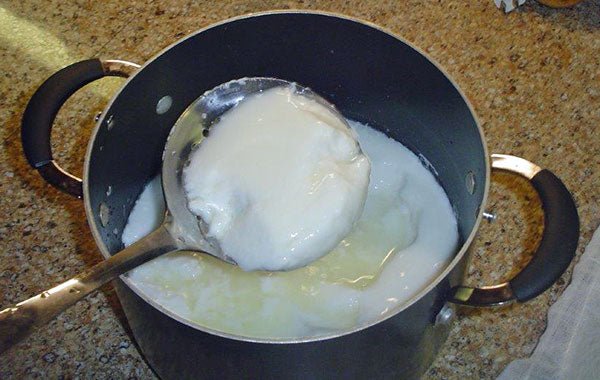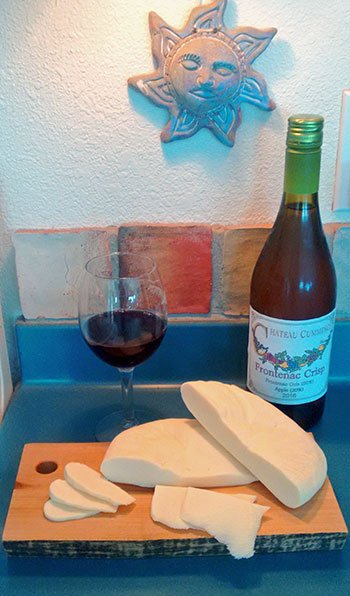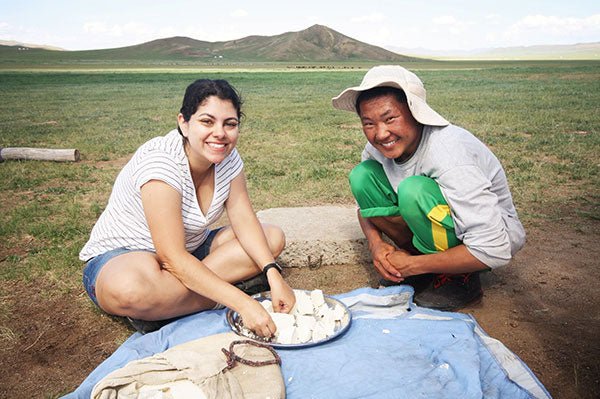
My Experiment
By Bob Albers
 Excuse me while I don my mad scientist hat. I have previously submitted an article on Creole Cream Cheese. I like it as a breakfast food. That’s how it is normally eaten hereabouts (Mandeville, Louisiana).
Excuse me while I don my mad scientist hat. I have previously submitted an article on Creole Cream Cheese. I like it as a breakfast food. That’s how it is normally eaten hereabouts (Mandeville, Louisiana).
There are a couple of things that have troubled me about the recipe and method that just don’t seem right. First of all, it is my deep seated belief that the origin of most cheeses is a “happy accident.” Somewhere along the line, an inquisitive and/or adventurous mind decided to try a variation or two and either improved on the original or came up with something really different. The recipe we now base our cheese on is from the Gold Seal Creamery which published a recipe in the local paper. That recipe differs from what I observed my mother to do.
Whenever the milk soured, one of two things would happen. Either we would soon have biscuits or she would allow the milk to further sour, then pour the milk solids into a rather small cheese mold so the whey would drain off. Our milk was delivered (yes, in those days of the late ’40s or early ’50s the milkman delivered the milk in glass bottles to the front door) in quart bottles. So the soured portion may have been only a pint or so which only made enough for 1 serving.
Getting back to the published recipe – the milk is inoculated with cultured buttermilk and coagulated with Junket rennet. How much culture is there in ¼ cup of buttermilk? Does it vary from one producer to another? Considering the variable time between making the buttermilk by the producer and when I get to use it for my cheese, is the culture all that active anymore? There are just too many variables to get consistent results.
OK, here is what I proposed to do. Instead of the cultured buttermilk, I used a mesophilic culture. Also, I substituted 1/8 tablet of cheese making rennet for the ¼ tablet Junket. I based the size difference on the assumption that Junket is weaker than the commercially available cheese maker’s rennet. Likewise, since I have been using homogenized milk instead of the simply pasteurized product of old, I decided to add 1/16 tsp of calcium chloride to my ½ gal. of milk. I guess I really shouldn’t call this Creole cream cheese because I’m deviating from the classic recipe. Let’s call this Bob’s Breakfast Cheese.
Ingredients:
½ gal skimmed milk at 75° – 85° F
1/16 tsp. calcium chloride diluted in ¼ cup non-chlorinated water
1/8 rennet tablet diluted in1/4 cup non-chlorinated water.
½ packet C101 mesophilic culture (left over from a previous project)
Now, the first change: I placed the milk in a Teflon lined 6 qt. pot and added the calcium chloride. The next step was to bring the milk up to temperature.
It didn’t take long for 2 reasons. First, I left the milk on the counter since bringing it home (about 3 hours ago). Secondly, the pot was still warm from sterilizing the bowls, measuring spoons and ladle. Since it was December and the outside temperature was 55°F, I couldn’t use my outdoor heating method, but I could place the pot of milk on to simmer where the flames didn’t reach the bottom of the pot, thus warming the milk slowly as I stirred it.
It seemed that in no time at all, the milk was 82°F. Good enough. It was time to remove the pot from the heat and sprinkle the C101 mesophilic culture atop the milk. 15 minutes later, I poured in the rennet and gave the milk a good stir for a minute or two. (1)
Here’s the easy part. It was 10:30 PM. I placed the pot of inoculated milk atop the refrigerator in my laundry room (a warm spot) and went to bed. Guten nacht.
Since none of that above is unique to this cheese, I didn’t bother with pictures. From this point on, there were some unique things going on, so the photos start.

December 31, 2016
Ah, it was morning-New Year’s Eve. I had done my morning chores. I was happy, my wife was happy-so was the cat. Since I had used a different rennet than before, I checked for a clean break. Got it, and only 12 hours instead of the normal 24 to 36 hours.

Until then, everything I had done was something I’m sure you’ve seen in countless cheese making articles & videos so, I won’t bore you with pictures. But, now, the creole cream cheese method differs from other cheeses:

First, I lined my stainless steel sink strainer with butter muslin. Then, I ladled the curd into the strainer.
After washing the pot which was used for ripening & coagulating the curd, I used it to sterilize the molds, 2 at a time.

Creole cream cheese molds are a bit different than what is used for other cheeses. They are typically plastic food containers (butter, margarine, sour cream or any convenient pint sized container into which you’ve punched dozens of holes in both the bottom & sides). Each mold was filled with from 4 to 8 oz. of curd. Here’s a picture of one of the molds which I inherited from my mother-in-law.

While the molds were being sterilized, I encouraged a more rapid draining of the curd by gently lifting each side of the butter muslin in turn, which caused half the curd to roll atop the other half while forcing the whey which was atop the curd to drain off.

My wife gave me one of her old cookie sheets to use for my cheeses. It is well worn from the cookie service so, I lined it with aluminum foil. A cooling rack was placed on the cookie sheet. The cheese molds were put on the cooling rack.

It looked like my curd (still wet) weighed 1 lb. 6 oz. or 22 oz. Dividing by 4, we get 5½ oz. That’s how much curd we put into each mold.

The cookie sheet with the cheese molds was placed in the refrigerator for about 24 hours to allow as much whey as possible to drain into the aluminum foil lined cookie sheet.

January 1, 2017:
After draining for 24 hours, the total cheese weight was 18 oz. I decided to divide it into three 6 oz. servings. This was just a little too late for my New Year’s breakfast so I decided to have one the next day. If you are interested in what I had for my breakfast that New Year’s day, it was my “North & South of the border eggs” (2) and a mimosa made with my very own orange juice. One of the benefits of living as far south as I do is having orange trees in the back yard. The down side is I have to buy apples.
January 2, 2017:
YUM! The cheese was firmer than previous creole cream cheese and also more flavorful. I attribute the flavor to the culture (M101) and the firmness to the rennet and calcium chloride. Perhaps next time I’ll use the buttermilk culture, C21, or flora danica, C11. Lipase anyone?
OH! I just looked at the supplies part of the “cheesemaking.com” website. It seems that the main difference between Creole cream cheese and regular cream cheese is the amount of milk fat in the cheese.
It’s great fun to find a cheese you like to eat & make, then, play around with it a bit. Sometimes you’ll come up with something you like and there might also be a flop or two. To paraphrase Thomas Edison-“My experiments are not failures; I now know so many ways not to make a cheese.” The paraphrase is kind of loose but you get the idea. Try something different!
Footnotes:
1 I’ve often wondered why, with some cheeses, the culture & rennet are added simultaneously and with others, the culture is allowed to work a while before renneting.
2 Place eggs in a poacher which has one compartment for each egg. Top each egg with a teaspoon of your favorite salsa (that’s the South of the boarder) optionally a small slice of cheese, then a slice of Canadian bacon (the North of the border). Poach ’till the eggs are to your liking & serve over buttered toast.














































































































































